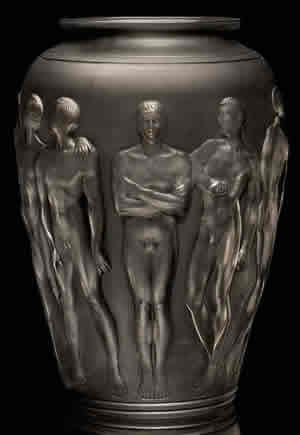In ancient Greece, the Palaestra evolved into a wrestling center built in many cities at public expense. But they weren’t just big wrestling rooms or gymnasiums. They also had social rooms, dressing rooms, educational areas, and baths.
 While Homer’s Lliad describes wrestlers in loincloths (somewhere between 1200 B.C. and 800 B.C.), wrestling at the Palaestra later developed into a sport where both training and competition were conducted in the nude
While Homer’s Lliad describes wrestlers in loincloths (somewhere between 1200 B.C. and 800 B.C.), wrestling at the Palaestra later developed into a sport where both training and competition were conducted in the nude
The “no uniform” program is not as surprising as it might seem to some today, from a view looking backwards in time over 2000 years. Ignoring the fact that Spandex** had not yet been invented :), consider that the Greek version of wrestling was a stand-up battle where the object was to throw your opponent to the ground. If the opponent’s back touched the ground, the guy still standing got a point. The first person to get three points was the winner of the match. There was no rolling around on the mat in the way wrestling is practiced today. So there was no trying to pin your opponent. And any kind of hold you placed on your opponent was only permitted on the upper body. The sport is said in legend to have been invented by Theseus, a hero of Greek Mythology depicted below in the center of the photo.
And there you have in a few erudite paragraphs the historical and artistic inspiration for one of the largest and dramatic Rene Lalique Vases, the Palestre. 40 centimeters tall and first introduced in 1928 just before the start of the great worldwide depression, it features a design consisting of a band of nude male athletes in various poses surrounding the entire outside of the great R. Lalique Vase model.
 On December 12th at Christie’s Rockefeller Center in New York, Lot 35 in the sale of a private art deco collection was a frosted and stained version of this vase estimated at $80,000 – $120,000. At the estimate it would have been a record price for this model. However in frenzied bidding tapering down (as always) to the two most determined bidders, the vase made a premium inclusive total of $362,500.
On December 12th at Christie’s Rockefeller Center in New York, Lot 35 in the sale of a private art deco collection was a frosted and stained version of this vase estimated at $80,000 – $120,000. At the estimate it would have been a record price for this model. However in frenzied bidding tapering down (as always) to the two most determined bidders, the vase made a premium inclusive total of $362,500.
The price is not only a world record price at auction for a Palestre Vase, but it’s a world record price for any commercial or production R. Lalique Vase. A few Cire Perdue Vases have sold for more (and possibly one or two auction sales of the early limited (a few or less examples) mold blown vases have topped this price), but no production vase in color or otherwise has reached this lofty height.
Even in this frothy market (a froth which mainly continues notwithstanding the spotty worldwide economic conditions), the result is a bit surprising. The final price, when viewed as part of the string of record price accomplishments for R. Lalique glass and other objects at auction this year, reflects the increasing appreciation among decorative arts buyers of the important artistic and industrial accomplishments of the great Rene Joules Lalique.
**Spandex was invented in 1959 in the Dupont Lab in Waynesboro Virginia by Joseph Shivers and C. L. Sandquist. The brand name Spandex is just an anagram for “expands”. Outside of the U.S. it is called different things in other countries such as the brand name Lycra in the U.K., elasthanne in France, and other local variants of elastane in Germany, Spain, Italy, and many other countries.
All Articles on These Topics: R Lalique Rene Lalique Auctions News and Results, R Lalique Vases and Rene Lalique Vases

